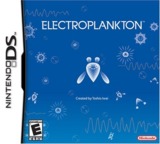Sometimes a random noise machine, sometimes a true composition tool, Electroplankton is an always-amusing music toy.
The Bad: Not a proper "game" if you're expecting that; no save/export feature.
The definition of "videogame" has been changing a lot over the years in order to accommodate new forms of interaction. But even if that's the case it's still hard to file Electroplankton under that category due to a lack of some key (for most gamers) attributes as "challenge" or proper "goals" within its design.
With that out of the way--I mean, exchanging "videogame" for "virtual toy" in its label--it becomes easier to enjoy (and recommend in my case) Electroplankton to anyone curious about being creative with music.
Designed by the Japanese multimedia artist Toshio Iwai Electroplankton is a collection of ten sound editing/generating/mixing "levels" available in two modes: "Audience" (for just watching some previously recorded stuff) and "Performance" (where you interact with the levels' elements to generate music). Obviously the most interesting mode is "Performance", and here the diversity in how one can toy with sounds may be a lasting joy in itself--even if just for the sake of curiosity. Aside that the weird and intriguing presentation adds another personality touch that's much more than a superficial coat of paint--in fact it's an integral part of the game's design and it delights the player just as much as the sound does.
Some of the modes are just playgrounds for blips and clicks that allow you to create a little funny mess, like "Hanenbow" (where you throw tadpoles at some inclinable leaves as they resound) or "Sun-Animalcule" (drop little "sun-seeds" that grow in size and intensity--visually and musically--until they disappear).
But for those wanting to dig deeper there are a few levels that can be taken more seriously as composition tools since their elements are more "controllable". Take "Rec-Rec", a four-track recorder ("recorder" here means a fish that eats the sound you yell at it) that takes advantage of the DS built-in mic with a nice amount of base beat options and adjustable speed as an example; or "Luminaria", where four light beings (each moving in a different speed but still evenly related regarding tempo) run in a labyrinth of movable arrows ("arrows" going for "notes").
Anyway there is a downside that affects everyone. Be the player a casual user or a music aficionado he/she will eventually face the disappointment of not being able to record their work. At times one can bring some neat stuff up and just have to throw it all away due to the lack of such a clearly desirable feature. Of course, implementing that would demand a huge amount of memory to make it work and all, but the way it is it's just plain frustrating.
In the end Electroplankton has the potential to amuse/entertain any "gamer" (or non-gamer for that matter) slightly interested in music--pretty much anyone, actually--if they can overcome the "videogame" expectation and "play" with it in every sense of the word.

